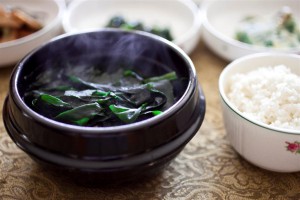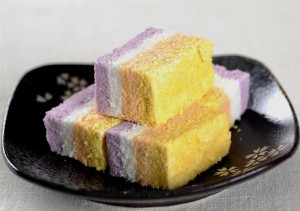Many cultures have their typical food that is served for holidays such as Christmas or Easter, but what I found out about ceremonial food in Korea is quite surprising for me. In Korea is tradition to cook special dishes to mark important moments of someone’s life as rites of passage from one phase of your life to another. This habit comes from the past and specifically from Confucianism that emphasize the importance of these occasions. This special moments of life or rites of passage are for example birth, birthday or funerals.
The birth ceremony starts before the delivery of the baby, when bowls of rice of seaweed soup are prepared and the family members pray the Samshin (the goddess of birth). After a woman delivers the baby she is served for the following seven days with rice and seaweed soup , believed to be good for a quick recovery.

The next ceremony takes place on the 100th day from the delivery of the baby and it’s called Baegil. It’s the first time I hear about a 100th day celebration since in Western Countries only the birthday is celebrated every year. During Baegil rice and seaweed soup are served to the mother and after she has consumed them, the celebration can start and food is arranged. Different rice cakes are served including steamed rice cake, rice cakes with sweet red beans and rice cakes steamed on pine needles. These rice cakes represents purity, strength and health.
The celebrations for the first birthday (doljanchi) are more elaborate than the 100th day ceremony and on the banquet table many items are spread out such as cookies, rice cakes, money, paper and writing brush. The main food served are rice cakes, as for Baegil, and fruit. A particular layered rice cake is served that is called (rainbow cake) and also other rice cake with cinnamon and coloured powder. These banquet is shared with families and neighbours.

The funeral ceremony is probably one of the most solemn ceremony in Korean culture and also the banquet reflects it. There are many rules for arranging and serving the food during a funeral. On the table (facing it) the skewered fish is placed to the east and the skewered meat on the west together with seasoned slices of meat. Red fruits are placed to the east and white ones to the west. Dates, chestnuts, pears and persimmons are placed from west to east in the top row in that order.
These traditional ways of celebrating the rites of passage are nowadays more rare and influenced by Western culture although some are still very common, like serving seaweed soup and rice to a newly mother.
These examples on how the food is important in each ceremony, confirms a general aspect of Korean culture that I somehow feel familiar because is also part of my background. Food is considered as nutrient but is also a way to celebrate birthdays, wish health and luck, or to say farewell to our beloved ones.
